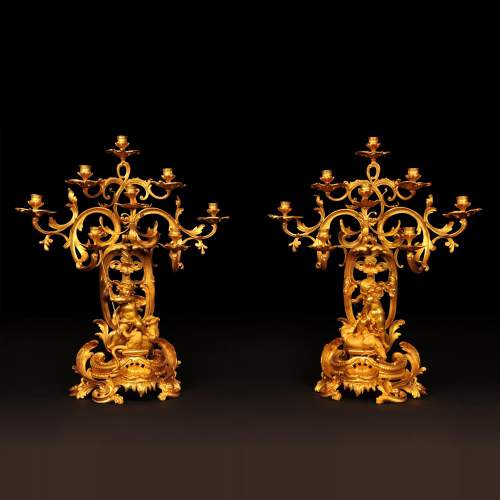Style Neo-Renaissance / Ref.13255
Charles HUNSINGER ( 1823-1893) and Marie PUISOYE (around 1840 - ?) : Neo-Renaissance Cabinet
Dimensions
Width 39'' ⅜ 100cm
Height 69'' ⅝ 177cm
Depth: 17'' ¾ 45cm
Origin:
Ebony, wood from lemon tree, enamel. After 1881 - before 1893
Signed "Hunsinger Paris" on the lock. The enamels are signed: "M. Puisoye" This Neo-Renaissance style doubled bodied cabinet, in ebony veneer and cube marquetry, joined by two pairs of thin lateral columns, has a notched frieze at the top, making a slight indentation in the central part. This frieze is on top of a carved smaller lintel, decorated in the middle by an enamel plaque featuring a naked woman and putti figurines, above a door that opens on to a lemon tree. Two small plaques featuring a putto and a round plaque with the initials “RR” above another arched plaque representing Galatée on a marine tank in the shape of a shell pulled by dolphins, signed on the bottom left “M. Puisoye” decorate this door. Just below the enamel of Puisoye there is another rectangular plaque decorated with foliage. On either side of the central part there are two circular plaques featuring Cupid. Finally, two columns carved with acanthus leaves at the base frame the upper part. These two columns are extended by another pair of straight columns, moulded at the base, framing the lower part of the cabinet. A drawer, just below the upper part of the cabinet, is decorated with a carved frieze and also supported by a pair of columns, whereas the rest of the lower part is plain and rests on a staircase base. The whole of the cabinet rests on four rounded feet. The signature present on the lock of this cabinet tells us the creator of this cabinet, Charles Hussinger. He was born in Alsace, in Dossenheim, on the 4th February 1823. His name appeared around 1859 in the Almanachs du Commerce, described as “manufacturer of luxury and fancy furniture”, the same year that he set up his workshop at 244 rue du Faubourg Saint-Antoine. He was known for producing furniture made out of ebony and encrusted with ivory, marquetry furniture, marriage baskets, etc. In 1867, he moved his workshop to 56 rue de la Roquette, workshop that he kept whilst opening another at 13 rue Sedaine in 1874. He became associated with Charles Adolphe Frédéric Wagner in 1872, and together they were present at a number of exhibitions. Finally, Hussinger's work was present at the Exhibitions in Paris in 1865, 1867, 1878 and 1889. He won a silver medal at the Universal Exhibition of 1878 and a gold medal in Brussels in 1881. The Hunsigner and Wagner association lasted about 10 years, just before Wagner retired around 1882. The same year, Husinger opened a shop at 13 rue des Pyramides and once again ran it on his own until his death on 12th March 1893. Hunsinger's furniture is very renowned and a beautiful example of his furniture; dated 1879, is conserved at Musée d'Orsay (OAO1001). The furniture that we present to you here is a privileged example of Husinger's art, made by the help of enamel artist, Mairie Puisoye. She was at the Salon of 1877 where she presented a portrait on porcelain and who was the pupil of Mme D. de Cool. At the Universal Exhibition of 1878, she displayed within her class, enamels and faience (class 69). The same year, at the Salon, she displayed enamels known as “limousins” enamels. Very early on, she showed a predilection for the work of Raphaël, for example in 1879, she displayed an enamel titled “Le Temps”, based on Raphaël's work. This interest in Raphaël's work is important to note with regards to the furniture that we are presenting here. In fact the central scene showing Galathée is a copy of fresco painting by Raphaël tilted “The triumph of Galathée”, made in 1514 for the Farnésine. Here we see the character of Galathée, in a conch, being pulled by two dolphins. The putto from the original version is also present here. During the exhibition of the society of French Artists in 1881, Marie Puisoye presented an enamel called “Galathée” enamel, perhaps the same enamel used on this cabinet. From this same year she was a student of the greatest enameller of the 19th century, Claudis Popellin, whose artistic touch we see in Marie Puisoye's works of art. There are also other enamels on this cabinet, used on scenes which are taken from Raphael's same work, such as the two medallions with smalls cupids are directly taken from “Triomphe de Galathée” in “la Famésine”. In the upper part of this cabinet, a rectangular enamelled plaque features a naked woman lying down. It is a copy of the painting “Venus” by Alexandre Cabanel, presented at the Salon of 1863 and bought there by Napoloen III. Today it is kept at the Musée d'Orsay in Paris. This cabinet shows the widespread use of enamel plaques in cabinet making, under the influence of Sauvrezy. Inspired by the Renaissance style, this cabinet is an example of a typical creation from the second half of the 19th century, by the new association of old techniques.
Recommended for you :
Dimensions:
Width: 67
Height: 82
Depth: 26
Dimensions:
Width: 133
Height: 251
Depth: 4
Dimensions:
Width: 143
Height: 296
Depth: 6
Dimensions:
Width: 161
Height: 255
Depth: 5
Dimensions:
Width: 144
Height: 296
Depth: 5
Dimensions:
Width: 143
Height: 300
Depth: 5
Dimensions:
Width: 161
Height: 245
Depth: 5
Dimensions:
Width: 284
Height: 262
Depth: 4
Dimensions:
Width: 98
Height: 313














